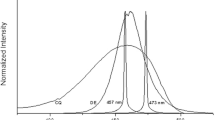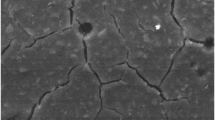Abstract
Challenges especially in the minimal invasive restorative treatment of teeth require further developments of composite polymerization techniques. These include, among others, the securing of a complete polymerization with moderate thermal stress for the pulp. The aim of this study is to compare current light curing sources with a blue diode laser regarding curing depth and heat generation during the polymerization process. A diode laser (445 nm), a LED, and a halogen lamp were used for polymerizing composite resins. The curing depth was determined according to the norm ISO 4049. Laser output powers of 0.1, 0.5, 1, and 2 W were chosen. The laser beam diameter was adapted to the glass rod of the LED and the halogen lamp (8 mm). The irradiation time was fixed at 40 s. To ascertain ΔT values, the surface and ground area temperatures of the cavities were simultaneously determined during the curing via a thermography camera and a thermocouple. The curing depths for the LED (3.3 mm), halogen lamp (3.1 mm) and laser(0.5/1 W) (3/3.3 mm) showed no significant differences (p < 0.05). The values of ΔTsurface as well as ΔTground also showed no significant differences among LED, halogen lamp, and laser(1 W). The ΔTsurface values were 4.1LED, 4.3halogen lamp, and 4.5 °C for the laser while the ΔTground values were 2.7LED, 2.6halogen lamp, and 2.9 °C for the laser. The results indicate that the blue diode laser (445 nm) is a feasible alternative for photopolymerization of complex composite resin restorations in dentistry by the use of selected laser parameters.





Similar content being viewed by others
References
Sgolastra F, Severino M, Gatto R, Monaco A (2013) Effectiveness of diode laser as adjunctive therapy to scaling root planning in the treatment of chronic periodontitis: a meta-analysis. Lasers Med Sci 28(5):1393–1402. https://doi.org/10.1007/s10103-012-1181-5
Saydjari Y, Kuypers T, Gutknecht N (2016) Laser application in dentistry: irradiation effects of Nd:YAG 1064 nm and diode 810 nm and 980 nm in infected root canals – a literature overview. Biomed Res Int 2016:Article ID 8421656:1–10. https://doi.org/10.1155/2016/8421656
Reichelt J, Winter J, Meister J, Frentzen M, Kraus D (2017) A novel blue light laser system for surgical applications in dentistry: evaluation of specific laser-tissue interactions in monolayer cultures. Clin Oral Investig 21(4):985–994. https://doi.org/10.1007/s00784-016-1864-6
Cook WD (1982) Spectral distributions of dental photopolymerization sources. J Dent Res 61(12):1436–1438. https://doi.org/10.1177/00220345820610121201
Stansbury JW (2000) Curing dental resins and composites by photopolymerization. J Esthet Dent 12(6):300–308. https://doi.org/10.1111/j.1708-8240.2000.tb00239.x
Leonard DL, Charlton DG, Roberts HW, Cohen ME (2002) Polymerization efficiency of LED curing lights. J Esthet Restor Dent 14(5):286–295. https://doi.org/10.1111/j.1708-8240.2002.tb00524.x
Heintze SD, Rousson V (2012) Clinical effectiveness of direct class II restorations – a meta-analysis. J Adhes Dent 14(5):407–431. https://doi.org/10.3290/j.jad.a28390
Jandt KD, Mills RW (2013) A brief history of LED photopolymerization. Dent Mater 29(6):605–617. https://doi.org/10.1016/j.dental.2013.02.003
Binnewies M (1986) Chemie in Glühlampen. Chemie Unserer Zeit 20(5):141–145 [German]. https://doi.org/10.1002/ciuz.19860200502
Friedman J (1989) Variability of lamp characteristics in dental curing lights. J Esthet Dent 1(6):189–190. https://doi.org/10.1111/j.1708-8240.1989.tb00500.x
Jandt KD, Mills RW, Blackwell GB, Ashworth SH (2000) Depth of cure and compressive strength of dental composites cured with blue light emitting diodes (LEDs). Dent Mater 16(1):41–47. https://doi.org/10.1016/S0109-5641(99)00083-4
Rueggeberg FA (2011) State-of-the-art: dental photocuring – a review. Dent Mater 27(1):39–52. https://doi.org/10.1016/j.dental.2010.10.021
Anić I, Pavelić B, Perić B, Matsumoto K (1996) In vitro pulp chamber temperature rises associated with the argon laser polymerization of composite resin. Lasers Surg Med 19(4):438–444. https://doi.org/10.1002/(SICI)1096-9101(1996)19:4<438::AID-LSM9>3.0.CO;2-T
Blankenau RJ, Powell GL, Kelsey WP, Barkmeier WW (1991) Post polymerization strength values of an argon laser cured resin. Lasers Surg Med 11(5):471–474. https://doi.org/10.1002/lsm.1900110513
Kelsey WP 3rd, Blankenau RJ, Powell GL, Barkmeier WW, Cavel WT, Whisenant BK (1989) Enhancement of physical properties of resin restorative materials by laser polymerization. Lasers Surg Med 9(6):623–627. https://doi.org/10.1002/lsm.1900090613
Kelsey WP, Blankenau RJ, Powell GL, Barkmeier WW, Stormberg EF (1992) Power and time requirements for use of the argon laser to polymerize composite resins. J Clin Laser Med Surg 10(4):273–278. https://doi.org/10.1089/clm.1992.10.273
Powell GL, Kelsey WP, Blankenau RJ, Barkmeier WW (1989) The use of an argon laser for polymerization of composite resin. J Esthet Dent 1(1):34–37. https://doi.org/10.1111/j.1708-8240.1989.tb01035.x
Potts TV, Petrou A (1990) Laser photopolymerization of dental materials with potential endodontic applications. J Endod 16(6):265–268. https://doi.org/10.1016/S0099-2399(06)81627-4
Rode KM, de Freitas PM, Lloret PR, Powell LG, Turbino ML (2009) Micro-hardness evaluation of a micro-hybrid composite resin light cured with halogen light, light-emitting diode and argon ion laser. Lasers Med Sci 24(1):87–92. https://doi.org/10.1007/s10103-007-0527-x
Rueggeberg FA, Ergle JW, Mettenburg DJ (2000) Polymerization depths of contemporary light-curing units using microhardness. J Esthet Dent 12(6):340–349
Ernst CP (2005) Aktuelle klinische Aspekte der Lichtpolymerisation. ZWR-Das Deutsche Zahnärzteblatt 114(11):513–517 [German]. https://doi.org/10.1055/s-2005-922467
Zach L, Cohen G (1965) Pulp response to externally applied heat. Oral Surg Oral Med Oral Pathol 19(4):515–530. https://doi.org/10.1016/0030-4220(65)90015-0
Ericson D, Kidd E, McComb D, Mjör I, Noack MJ (2003) Minimally invasive dentistry—concepts and techniques in cariology. Oral Health Prev Dent 1(1):59–72
Alonso V, Darriba IL, Caserio M (2017) Retrospective evaluation of posterior composite resin sandwich restorations with Herculite XRV: 18-year findings. Quintessence Int 48(2):93–101. https://doi.org/10.3290/j.qi.a37386
Małkiewicz K, Wychowański P, Olkowska-Truchanowicz J, Tykarska M, Czerwiński M, Wilczko M, Owoc A (2017) Uncompleted polymerization and cytotoxicity of dental restorative materials as potential health risk factors. Ann Agric Environ Med 24(4):618–623. https://doi.org/10.5604/12321966.1235159
ISO 4049 (2009) Dentistry - polymer-based restorative materials. EN ISO. International Organization for Standardization, Geneva, Switzerland, p 4049
Rueggeberg FA, Cole MA, Looney SW, Vickers A, Swift EJ (2009) Comparison of manufacturer-recommended exposure durations with those determined using biaxial flexure strength and scraped composite thickness among a variety of light-curing units. J Esthet Restor Dent 21(1):43–61. https://doi.org/10.1111/j.1708-8240.2008.00231.x
Price RB, Rueggeberg FA, Harlow J, Sullivan B (2016) Effect of mold type, diameter, and uncured composite removal method on depth of cure. Clin Oral Investig 20(7):1699–1707. https://doi.org/10.1007/s00784-015-1672-4
Flury S, Hayoz S, Peutzfeldt A, Hüsler J, Lussi A (2012) Depth of cure of resin composites: is the ISO 4049 method suitable for bulk fill materials? Dent Mater 28(5):521–528. https://doi.org/10.1016/j.dental.2012.02.002
DeWald JP, Ferracane JL (1987) A comparison of four modes of evaluating depth of cure of light-activated composites. J Dent Res 66(3):727–730. https://doi.org/10.1177/00220345870660030401
Lussi A, Zimmerli B, Aregger T, Portmann P (2005) Composite curing with new LED equipment. Schweiz Monatsschr Zahnmed 115(12):1182–1187 [German]
Halvorson RH, Erickson RL, Davidson CL (2002) Energy dependent polymerization of resin-based composite. Dent Mater 18(6):463–469. https://doi.org/10.1016/S0109-5641(01)00069-0
Steinhaus J, Hausnerova B, Haenel T, Großgarten M, Möginger B (2014) Curing kinetics of visible light curing dental resin composites investigated by dielectric analysis (DEA). Dent Mater 30(3):372–380. https://doi.org/10.1016/j.dental.2013.12.013
Shortall AC, Wilson HJ, Harrington E (1995) Depth of cure of radiation-activated composite restoratives-influence of shade and opacity. J Oral Rehabil 22(5):337–342. https://doi.org/10.1111/j.1365-2842.1995.tb00782.x
Bouillaguet S, Caillot G, Forchelet J, Cattani-Lorente M, Wataha JC, Krejci I (2005) Thermal risks from LED-and high-intensity QTH-curing units during polymerization of dental resins. J Biomed Mater Res B Appl Biomater 72(2):260–267. https://doi.org/10.1002/jbm.b.30143
Ferracane JL (2011) Resin composite—state of the art. Dent Mater 27(1):29–38. https://doi.org/10.1016/j.dental.2010.10.020
Manhart J (2010) Neues Konzept zum Ersatz von Dentin in der kompositbasierten Seitenzahnversorgung. ZWR-Das Deutsche Zahnärzteblatt 119(03):118–125 [German]. https://doi.org/10.1055/s-0030-1253176
Czichos H, Skotzki B, Werkstoffe SFG (2012) In: Akademischer Verein Hütte EV, Czichos H, Hennecke M (eds) Hütte – Das Ingenieurwissen, 34rd edn. Springer, Berlin, Heidelberg. https://doi.org/10.1007/978-3-642-22850-6
Lancaster P, Brettle D, Carmichael F, Clerehugh V (2017) In-vitro thermal maps to characterize human dental enamel and dentin. Front Physiol 8(461):1–8. https://doi.org/10.3389/fphys.2017.00461
Gente M, Apel E, Dikmen G, Hobeck C, Schipper H, Schmitz K, Wolkenhauer V (2007) Der Einfluss des Polymerisationslampentyps auf die Aushärtungstiefe dentaler Kompositfüllungen. ZWR-Das Deutsche Zahnärzteblatt 116(9):408–412 [German]. https://doi.org/10.1055/s-2007-991503
Moore BK, Platt JA, Borges G, Chu TG, Katsilieri I (2008) Depth of cure of dental resin composites: ISO 4049 depth and microhardness of types of materials and shades. Oper Dent 33(4):408–412. https://doi.org/10.2341/07-104
Price RB, Derand T, Sedarous M, Andreou P, Loney RW (2000) Effect of distance on the power density from two light guides. J Esthet Dent 12(6):320–327. https://doi.org/10.1111/j.1708-8240.2000.tb00241.x
Uhl A, Mills RW, Jandt KD (2003) Polymerization and light-induced heat of dental composites cured with LED and halogen technology. Biomaterials 24(10):1809–1820. https://doi.org/10.1016/S0142-9612(02)00585-9
Staehle HJ, Wolff D, Frese C (2015) More conservative dentistry: clinical long-term results of direct composite resin restorations. Quintessence Int 46(5):373–380. https://doi.org/10.3290/j.qi.a33718
Ebert J, Frankenberger R, Petschelt A (2012) A novel approach for filling tunnel-prepared teeth with composites of two different consistencies: a case presentation. Quintessence Int 43(2):93–96
Acknowledgments
The authors would like to thank Dentsply Sirona Germany for providing the blue diode laser system.
Funding
This study was funded under the research budget of AMLaReBO (Center of Applied Medical Laser Research and Biomedical Optics) at Bonn University.
Author information
Authors and Affiliations
Corresponding author
Ethics declarations
Materials sciences
Conflict of interest
The authors declare that they have no conflict of interest.
Ethical approval
Materials sciences
Informed consent
Materials sciences
Rights and permissions
About this article
Cite this article
Drost, T., Reimann, S., Frentzen, M. et al. Effectiveness of photopolymerization in composite resins using a novel 445-nm diode laser in comparison to LED and halogen bulb technology. Lasers Med Sci 34, 729–736 (2019). https://doi.org/10.1007/s10103-018-2651-1
Received:
Accepted:
Published:
Issue Date:
DOI: https://doi.org/10.1007/s10103-018-2651-1




